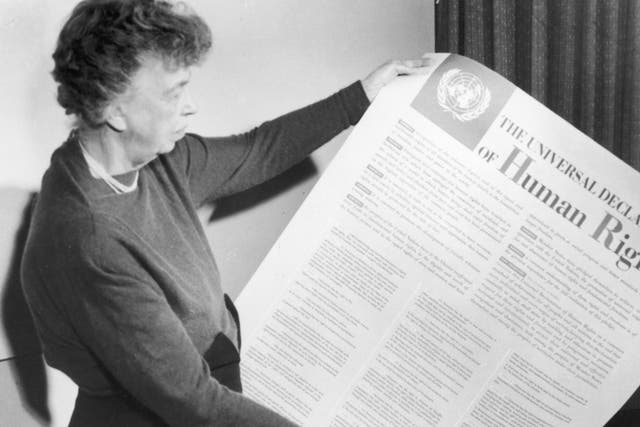
In the wake of World War II's horrors, Roosevelt saw the need to support refugees and affirm the right to education, shelter and medical care.
Updated: July 13, 2023 | Original: December 8, 2020

“The future must see the broadening of human rights throughout the world,” Eleanor Roosevelt told a crowd in September 1948 at the Sorbonne in Paris. “People who have glimpsed freedom will never be content until they have secured it for themselves… People who continue to be denied the respect to which they are entitled as human beings will not acquiesce forever in such denial.”
Roosevelt was there to speak about the Universal Declaration of Human Rights, a document whose drafting she’d overseen at the newly-formed United Nations. The U.N. adopted the document that year on December 10, a date now commemorated as Human Rights Day.
History Shorts: Eleanor Roosevelt's Diplomatic Fight for Human RightsThe rights enumerated in the declaration were controversial among the U.N.’s member nations, and remain so today. It proclaimed, among other rights, that “Everyone has the right to a standard of living adequate for the health and well-being of himself and of his family, including food, clothing, housing and medical care and necessary social services.” The former First Lady fought hard to make the declaration comprehensive and later wrote that she considered it “my most important task” during her years at the U.N.
The 51 countries that founded the U.N. did so in October 1945, just a couple of months after the end of World War II. In the wake of two world wars and the first nuclear bomb attacks, and in the midst of a global refugee crisis, many feared that a more destructive World War III was right around the corner. The U.N. was founded at a time when people like Eleanor Roosevelt wanted to avoid such a disaster and address human rights as a way of preventing war.
President Harry Truman appointed Roosevelt to the U.S. delegation to the U.N. at the end of 1945. By then, she was well-known in the U.S. and abroad. As First Lady during Franklin D. Roosevelt’s administration from 1933 to 1945, she championed poverty alleviation, access to education and civil rights, and traveled to the European and Pacific front lines of World War II. In April 1946, she became chair of the U.N. Commission on Human Rights and took on the task of drafting a human rights declaration for the world.
President Franklin D. Roosevelt feared losing Southern support for his New Deal legislation.
Franklin Roosevelt’s children offered physical, emotional and political support throughout his presidency.
The first lady did what she could to support Japanese Americans during WWII—without appearing to defy FDR's Executive Order 9066.
Roosevelt’s ideas about human rights and the need to work toward global peace were heavily influenced by her experiences during the two world wars. On the home front, she served food to World War I soldiers and “took the lead in making the federal government address shell-shocked sailors who were trapped in straight jackets in St. Elizabeth’s Hospital in D.C.,” says Allida Black, a scholar at UVA’s Miller Center for Public Affairs and editor emeritus of GWU’s Eleanor Roosevelt Papers Project.
She saw firsthand the death and devastation in Europe caused by the First and Second World Wars and continued to witness it during her U.N. appointment. In a column published in February 1946, she wrote about her visit to the Zeilsheim displaced persons camp in Germany. After meeting Jewish people who had survived the Holocaust, she reflected: “When will our consciences grow so tender that we will act to prevent human misery rather than avenge it?”
Creating the Universal Declaration for Human Rights was no easy task, given that nations like the U.S. and the Soviet Union couldn’t agree on what human rights were. Working on it required winning over people who disliked and disagreed with her like Republican John Foster Dulles, a U.S. delegate to the U.N. General Assembly who had protested the Democratic First Lady’s appointment. Roosevelt appealed to his Catholicism to get his support for including economic and social rights—which many U.S. conservatives disparaged as “communist”—in the declaration. And it worked.
“So the most hawkish Republican teams up with Eleanor Roosevelt to go to Harry Truman and the secretary of State to say, ‘We must have economic and social rights in this document; people must have access to food, they must have access to shelter, they must have access to education,’” Black says. “Imagine that.”
Hansa Mehta, a U.N. delegate from the newly-independent country of India and the only other woman on the Commission on Human Rights, also played a significant role in shaping the declaration. She is the one who suggested changing the declaration’s original language in the first article from “All men are born free and equal” to “All human beings are born free and equal,” says Blanche Wiesen Cook, a professor of history and women’s studies at CUNY and author of a three-volume biography of Eleanor Roosevelt.
Even though the declaration wasn’t a binding, enforceable treaty, it served as a model for legislation in many countries. After its adoption, Roosevelt continued to promote and speak about the declaration and the importance of human rights.
“She was very proud of the Universal Declaration of Human Rights and she thought that it would be quickly followed by binding covenants,” Cook says. “But she died in 1962 and the covenants weren’t even ready then, and the U.S. didn’t sign the civil and political rights covenant until George Herbert Walker Bush ratified it when the Soviet Union collapsed.”
The United States has not yet ratified the treaty’s economic and social rights covenant.
Stream World War II series and specials commercial-free in HISTORY Vault.